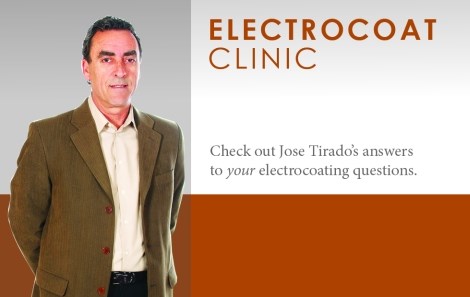ECOAT Q&A: Quoting E-Coat Costs
Q. I have a customer who wants me to quote his product line based on an average square-foot price without analysis of the parts. How can I accomplish this?

Q. I have a customer who wants me to quote his product line based on an average square-foot price without analysis of the parts. How can I accomplish this, since my selling price is basically based on the number of parts we can hang per carrier and number of carriers processed per hour? Also, what is the best way to calculate amount of e-coat applied per square foot of part? A.I.
A. To a certain extent, asking you to quote based on an average price per square foot without seeing the parts is not fair, since not all square feet coated cost the same. For example, a 1-sq-ft piece of 18-gauge galvanized is cheaper to electrocoat than a 1-sq-ft piece of ½-inch steel plate.
If you currently price based on pieces per carrier or load, you must have a dollar value you want to generate per carrier/load. In order for you to obtain that value, you must have obtained some numbers from your profit/loss statement (P&L) that included all costs plus profit, divided by the number of loads you ran during the time frame you used the P&L. If you also had the square-foot number from all those loads, then you could calculate your actual cost per square foot equivalent to your value per carrier/load and provide that number to your customer. I have seen some job shops use this technique. It is easy, and quickly generates quote numbers, but it is not good enough to determine efficiency and competitiveness of the coater.
To see the rest of Jose's answer, CLICK HERE
Related Content
-
Professional Plating Expands Zinc, Ecoat Offerings
Ever expanding, Professional Plating of Brillion, Wisc., has announced two capital investments: a second zinc line and an upgrade of its ecoat capabilities.
-
Sustainability, Electrification and Mobility
Industry events like ECOAT are good indicators of the trends that are top of mind for those in manufacturing.
-
ECOAT24 Issues Call for Speakers
Don't miss your chance to apply to speak at ECOAT24. Submit your abstract by June 26, 2023.















